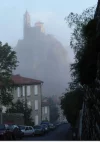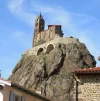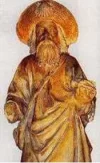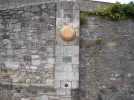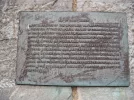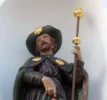You are refuting a claim that nobody made. Please reread post #50. (nature of GR65; starting point of
Camino Frances).
The Camino only "starts" in Le Puy from any mediaeval perspective or "full Camino" manner if that's where you happen to live ; you're calling "the paths of the GR65" a "modern invention", whereas even in the strictest practical terms that's inaccurate too -- the GR65 only diverges from the historical route for legal reasons which require hiking routes to avoid tarmac. And so what ? Deviations of this nature for specific purposes do not vanish away the historical nature of the Way, and they have been common occurrences throughout the entire History of the Camino.
Besides which, "the GR65" is not "the Camino", and it never has been -- it's a hiking trail mostly following the historic trace of the Camino between Le Puy and SJPP. But again, so what ? It is illegal in France to publish a hiking trail description that would put hikers at risk, and this is why the GR65 occasionally diverges from the historical path. It's certainly wrong to conflate the GR65 with the Camino from Le Puy onwards, not just because a pilgrimage isn't a
chemin de grande randonnée, but mostly because it can lead to false suppositions among the enthusiasts or the opponents of these GR itineraries.
The truth nevertheless is that travel itineraries are among the more common types of mediaeval documents, and that whilst too much can be made of the specific copy of an itinerary found in the Codex, it's hardly the only existing document concerning the way from Le Puy !!
The notion of "the full Camino" as if it started at Le Puy or SJPP or wherever is certainly a modern invention, of course, but to suggest that these modern accommodations with the pilgrim tradition might somehow invalidate that tradition and its historical origins is to throw the baby out with the bathwater.
Here is a 1986 map showing the network of all the ways in France leading to the Francès, as they were in the Middle Ages :
http://nationale10.e-monsite.com/medias/images/chemins-st-jacques.jpg
It's from the
Atlas historique des routes de France by G. Reverdy, a roads engineer and so a specialist in such questions.
As you can see, the Le Puy route would have been of no importance to any pilgrim not living in the region -- and just speaking personally, I've never set foot on that way (though I've visited Le Puy), and can honestly think of no reason why I should want to do so.
If all that you're trying to say is that there's nothing "special" about Le Puy that would make starting there "the full Camino", then OK -- but as for the history of that route, people converged on Le Puy on the way to Santiago for a reason, which is that it was (and is) a major pilgrimage destination in its own right, so that everyone from the region and from further away in that direction would naturally make their way to Le Puy as part of their journey. Just as most people starting from further away converge today in SJPP, even though there's nothing "special" about that place either.
But you said "
the irk is when one starts doing something hoping to be part of an extremely old tradition when in fact the tradition really is not what he or she thought and has fallen in the trap based on erroneous or misleading information" -- and I think it's a false approach, potentially constituting "erroneous or misleading information" in itself.
The traditional approach to doing a pilgrimage is, and always has been, to do it in a manner relevant to the here and now, and to present circumstances, and yet defined by the accumulative understanding of that pilgrimage as it has been added to over the decades or centuries since the pilgrimage began. Tradition is not some sort of unchanging and unchangeable relic of the past, but it is the living repository of a memory or a practice as it has been transmitted from the origins until today, and as we ourselves will transmit it to others, today and in the future.
The GR65 adds to the tradition of the Camino, as did the modern editions of the Codex Calixtinus from 1882 onwards, as did the revitalisation of the Camino in the 1990s and its recognition as a European cultural route, as did even Franco's ill-conceived 1965 attempt to turn it into a motor-vehicle holiday route.
One could denounce these modern re-interpretations and transformations as "myths", but to my mind it would be better to use the word "myth" in its more proper sense, as "a story attempting to provide a framework for understanding in symbolic or metaphorical purposes". The Camino in this sense is a living story, where the plot and the structure are already there, waiting only for the arrival of a main character, the pilgrim, in the midst of his crises to provide that story with flesh and meaning.
The traditional and modern understandings of the Camino all contribute to that story, positively, whereas attempts to "revisionise" all of that away can only ever achieve the opposite.








